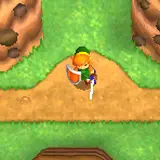 The Zelda franchise has been around for now over 25 years, and has spanned over 10 Nintendo game systems. You would think that after all of that, Eiji Aonuma and Nintendo would be running short on ideas on how to make each new game in the series fresh. Yet with each new release, Aonuma manages to prove us wrong.
The Zelda franchise has been around for now over 25 years, and has spanned over 10 Nintendo game systems. You would think that after all of that, Eiji Aonuma and Nintendo would be running short on ideas on how to make each new game in the series fresh. Yet with each new release, Aonuma manages to prove us wrong.
And that trend continues in The Legend of Zelda: A Link Between Worlds, the newest Zelda title for the Nintendo 3DS system. Instead of pushing the boundaries of the third dimension, or trying to make Link look, move and fight as realistically as possible, Nintendo has gone back to a simpler time: 1991, and has created a full-fledged sequel to the classic SNES game, The Legend of Zelda: A Link to the Past.
A Link Between Worlds (ALBW) tells the tale of an evil man named Yuga, who appears in Hyrule and begins turning the descendants of the seven sages into paintings and then whisks them away to his home dimension. A boy named Link gets pulled into the conflict, and when he miraculously survives being “painting-a-fied” by Yuga, he then begins his journey to stop Yuga and free the sages. Link’s adventure takes him to Yuga’s home dimension, Lorule, which is the dark opposite of Hyrule (Get it?). There, Link meets Princess Hilda, who tasks him with saving both Hyrule and Lorule, and the quest truly begins.
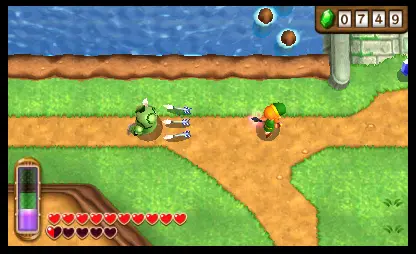
The story is drenched in classic Zelda themes, and the true blue pig version of Ganon even makes an appearance. As the story unfolds, the darker elements start to play out and The Legend of Zelda: A Link Between Worlds begins to really carve itself a unique–and welcome place–in the greater annals of the Legend that is Zelda.
The Legend of Zelda: A Link Between Worlds uses the same map layout from A Link to the Past, with Link’s house in the center, Hyrule Castle close by, and memorable places, like Death Mountain and the Eastern Palace, found in familiar locales. Kakariko Village is almost exactly the same as well, only the citizens (and those bully chickens) have been changed. The style of the game is classic top-down, with the perspective changing when Link uses his newfound ability to become a painting.
There are still plenty of eye-popping stereoscopic 3D elements in ALBW. Tektites leap high in the air around Link, which means they are literally jumping in the player’s face. When Link tosses a bomb, it lobs up into the player’s eyesight. It really works to make this game stand out visually. Dungeons that have multiple levels now with greater depth of field when dropping through holes, which the designers took full advantage of. And the lighting effects are well above and beyond anything that the SNES could have created back in 1991. A good example of this is in the snow-covered Lorule version of Death Mountain. The sun in the sky is at dusk, and the lighting on the crisp, white snow is breathtaking.
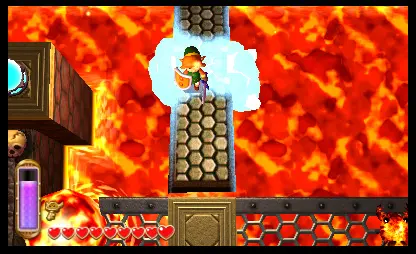
Gameplay is as tight as ever, but with some brand new–and much needed–additions. First of all, all of the tools, items and weapons that Link needs on his journey are available right up front–for a price. They can be rented from a mysterious merchant named Ravio, and can later be purchased–for an even higher price. While renting the items, if Link falls, every item is returned to Ravio and must be rented again. This adds an exciting new element of staying alive for financial reasons.
Another major change is that there is no set path to tackle the dungeons. Since each tool/item/weapon is available up front, most of the dungeons can be accessed at any time. There are some that need something more, and others that cannot be completely conquered until all items are held, but this freedom is new–and completely welcome–in a Zelda game.
And speaking of dungeons, the last major change in core gameplay is the dungeon map; as in it no longer exists. Each dungeon is mapped out as soon as Link enters, and only the compass can be found to show off where the hidden treasure chests are located. Seeing as some dungeons are puzzles in and of themselves, having the map handy from the get-go is marvelous.
The gimmick–because there has to be a gimmick–in The Legend of Zelda: A Link Between Worlds revolves around Link’s aforementioned ability to turn himself into a painting, which allows him to walk on walls. This new ability is amazingly helpful in exploring every corner of Hyrule/Lorule, and the way that the designers implement it seems natural and fluid.
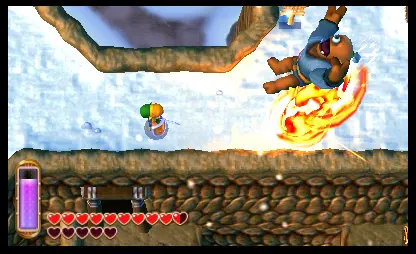
There are also enough side quests for Link to complete, including the hunt for Maimais, which are the lost children of a big purple octopus. Finding them all is beneficial to Link, as with every ten found, Mother Maimai will transform one of Link’s owned items into a more powerful version.
There is also the usual hunt for the heart containers, a few fetch quests, and the usual fun distractions and rupee earning mini-games that one expects from a Zelda game.
The musical score is classic Zelda, with the opening notes harking back to the exact same notes as in A Link to The Past. The new compositions by composer Ryu Nagamatsu are incredible. I especially like the song played in Mother Maimai’s cave. Music has always played a huge role in the Zelda mythos, and that continues in Between Worlds.
An incredible StreetPass feature has been added for the 3DS which allows for other gamer’s “Links” to visit your Hyrule in the guise of Shadow Links. These Shadow Links are equipped with two items–whichever two the Link was holding at the time of the StreetPass–and a sword, and once they are in your Hyrule, that can be challenged and a fight breaks out. The rewards are usually rupees, but there are over 50 unlockable StreetPass achievements to collect. Things like “Use the hookshot during the battle,” or “Win with a bomb.” It is undeniably one of the better StreetPass games that Nintendo has implemented.
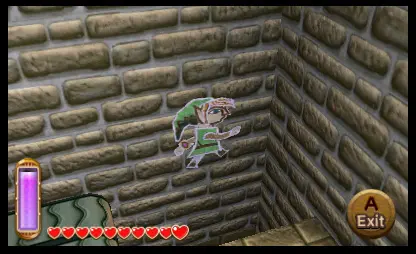
The Legend of Zelda: A Link Between Worlds is a perfect game for longtime fans of the series, or even just fans of epic adventure games with intuitive puzzle elements, insanely fun boss battles, and overall gorgeous graphics. The intelligent manner in which Eiji Aonuma and his team of magicians have created this wonderful experience is unparalleled in gaming–handheld or of console. This is an adventure that as soon as I finished, I wanted to play again. And there is a much harder Hero Mode that unlocks after the game is finished. That is a testament to not only how good this game is, but how good the Legend of Zelda series is, as a whole. For over 25 years, Nintendo has been rolling out these adventures of Link, and still, after all this time, they are still wowing and thrilling us all. But isn’t that what Legends are supposed to do? Isn’t that what makes them Legends in the first place?
The Legend of Zelda: A Link Between Worlds was reviewed on 3DS XL using a copy purchased at retail. It released exclusively for 3DS on November 22, 2013.



